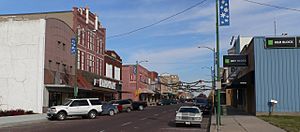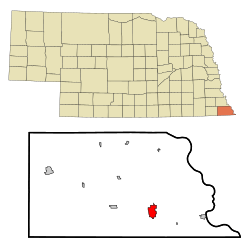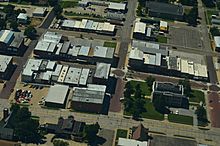Falls City, Nebraska facts for kids
Quick facts for kids
Falls City, Nebraska
|
|
|---|---|

Stone Street, looking north from 15th Street
|
|

Location within Richardson County and Nebraska
|
|
| Country | United States |
| State | Nebraska |
| County | Richardson |
| Area | |
| • Total | 3.35 sq mi (8.67 km2) |
| • Land | 3.34 sq mi (8.66 km2) |
| • Water | 0.01 sq mi (0.01 km2) |
| Elevation | 988 ft (301 m) |
| Population
(2020)
|
|
| • Total | 4,133 |
| • Density | 1,236.31/sq mi (477.38/km2) |
| Time zone | UTC-6 (Central (CST)) |
| • Summer (DST) | UTC-5 (CDT) |
| ZIP code |
68355
|
| Area code(s) | 402 |
| FIPS code | 31-16655 |
| GNIS feature ID | 2394740 |
| Website | fallscityonline.com |
Falls City is a city in southeastern Nebraska, United States. It is the main town, or county seat, of Richardson County, Nebraska. In 2020, about 4,133 people lived there.
Contents
History of Falls City
Falls City was started in the summer of 1857. Four people named James Lane, John Burbank, J.E. Burbank, and Isaac L. Hamby founded it. The town is located on the north side of the Big Nemaha River.
The town got its name from a four-foot rock ledge in the river. This spot was called the "Falls of Nemaha." Over time, the river has changed, and the falls are no longer there.
Falls City was a stop on the Underground Railroad. This was a secret network that helped enslaved people escape to freedom. This happened during the time of the Kansas–Nebraska Act.
Early on, Falls City worked hard to become the county seat for Richardson County. Another town, Salem, Nebraska, was first chosen. But Salem did not have a good building site. After a few elections, Falls City finally became the permanent county seat in 1860.
The city grew a lot in the late 1800s. This was because railroads came to town. The Atchison and Nebraska Railroad arrived in 1871. The Missouri Pacific Railroad came in 1882. Falls City became an important stop for these trains.
The number of people living in Falls City reached its highest point in 1950. About 6,200 citizens lived there at that time. In 1966, a plane crash happened near Falls City due to bad weather.
Geography of Falls City
Falls City covers a total area of about 3.06 square miles (7.93 square kilometers). Most of this area is land, about 3.05 square miles (7.90 square kilometers). A very small part, 0.01 square miles (0.03 square kilometers), is water.
Population Information
Falls City has seen its population change over the years. The number of people living in the city has gone up and down.
| Historical population | |||
|---|---|---|---|
| Census | Pop. | %± | |
| 1870 | 607 | — | |
| 1880 | 1,583 | 160.8% | |
| 1890 | 2,102 | 32.8% | |
| 1900 | 3,022 | 43.8% | |
| 1910 | 3,255 | 7.7% | |
| 1920 | 4,930 | 51.5% | |
| 1930 | 5,787 | 17.4% | |
| 1940 | 6,146 | 6.2% | |
| 1950 | 6,203 | 0.9% | |
| 1960 | 5,598 | −9.8% | |
| 1970 | 5,444 | −2.8% | |
| 1980 | 5,374 | −1.3% | |
| 1990 | 4,769 | −11.3% | |
| 2000 | 4,671 | −2.1% | |
| 2010 | 4,325 | −7.4% | |
| 2020 | 4,133 | −4.4% | |
| U.S. Decennial Census 2012 Estimate |
|||
What the 2010 Census Showed
In 2010, there were 4,325 people living in Falls City. There were 1,931 households, which are groups of people living together. The city had about 1,418 people per square mile.
Most people in Falls City were White (93.1%). There were also smaller groups of African American, Native American, and Asian people. Some people were from other races or from two or more races. About 1.5% of the population was Hispanic or Latino.
About 27% of households had children under 18 living with them. Many households (44%) were married couples. The average age of people in the city was 44.4 years old.
Education in Falls City
Falls City has a public school system called Falls City Public Schools. It includes two elementary schools and a junior high school. There is also Falls City High School.
Another option for education is Sacred Heart School. This is a Catholic school that teaches students from kindergarten through 12th grade.
Culture in Falls City
In 2013, the local sheriff, Randy Houser, described the area's way of thinking. He said it was about "mind your own business, live your own life." This shows a common belief in personal freedom and privacy.
Religion in Falls City
In 1997, the largest Christian group in Falls City was Catholicism. This means that many people in the city followed the Catholic faith.
Famous People from Falls City
Many notable people have come from Falls City, including:
- Charlie Abbey, a baseball player
- David Abbot, a magician and debunker
- Jim Bethke, a baseball player
- Gil Dodds, a famous runner who held world records
- Elmer "Skip" Dundy, a showman who created world's fair attractions
- Pee Wee Erwin, a jazz musician
- John Philip Falter, an illustrator for the Saturday Evening Post
- Lloyd Hahn, an Olympic runner
- Dave Heineman, who became the 39th governor of Nebraska
- Patricia McGerr, an American crime writer
- John H. Morehead, the 17th governor of Nebraska
- Patricia S. Morehead, a Nebraska state legislator and teacher
- C. Frank Reavis, a U.S. Representative for Nebraska
- Arthur J. Weaver, the 22nd governor of Nebraska
- David Wiltse, a mystery novelist and playwright
Images for kids
See also
 In Spanish: Falls City (Nebraska) para niños
In Spanish: Falls City (Nebraska) para niños





